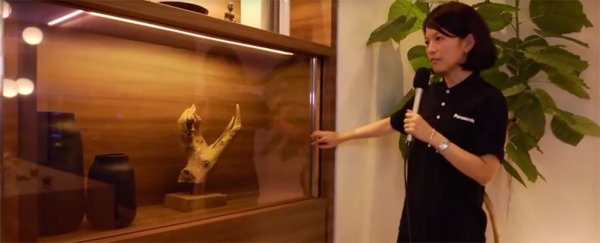Since the arrival of flat-screen TVs, there's not been a whole lot to get excited about in the world of televisions - how many ways can you improve on a big slab of glass, after all? Well, how about by making it almost invisible when you're not using it?
That's the thinking behind a new prototype from Panasonic that's just been shown off at the CEATEC electronics expo in Japan this week. When switched on, it's just like a normal TV. When switched off, it's as transparent as glass, meaning you can see the wall or shelving behind.
Panasonic describes it as the "future of display screens" - although as you might expect, the company's staying tight-lipped about the technology behind its transparent TV, just in case its competitors have something similar in mind.
According to Mat Smith at Engadget, the screen is made from a fine mesh embedded in a glass panel.
You can slide the panel around too, at least in Panasonic's demo clip, where the TV performs double duty glass pane of a cabinet:
Because it can be moved around, you can easily get at shelves behind it, or adjust the height of the display depending on who's watching.
Importantly, the screen uses the latest OLED (organic light-emitting diode) technology, where each pixel lights itself (rather than being lit from behind).
Traditionally, OLED panels put a thin layer of plastic between two electrodes on top of a glass slab. Because of this, when the electric signal disappears, the slab can look virtually transparent.
OLED technology requires very little power too, which is why panels like this can be so thin. Eventually, tech firms are hoping to develop flexible OLED screens that you can bend or even roll away.
And this isn't just for your favourite crime drama or soap opera either - Panasonic's marketing spiel envisions people using the display to control smart home devices, play music, or maybe even set the mood with a series of themed images.
Panasonic originally showed off the technology at CES in Las Vegas earlier in the year, but the company's engineers say the latest version of their invisible television looks even more transparent when switched off, and brighter when switched on.
Unfortunately, despite the progress they're making, it looks like it won't be ready to buy for another three years or so, according to company representatives.
But that might actually be a good thing - it'll give us some time to save up for it.
